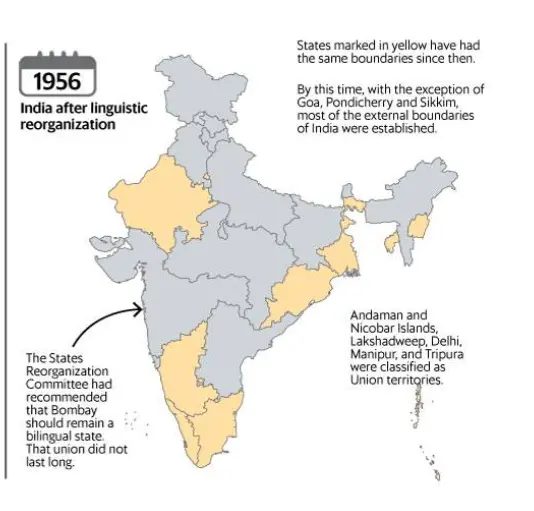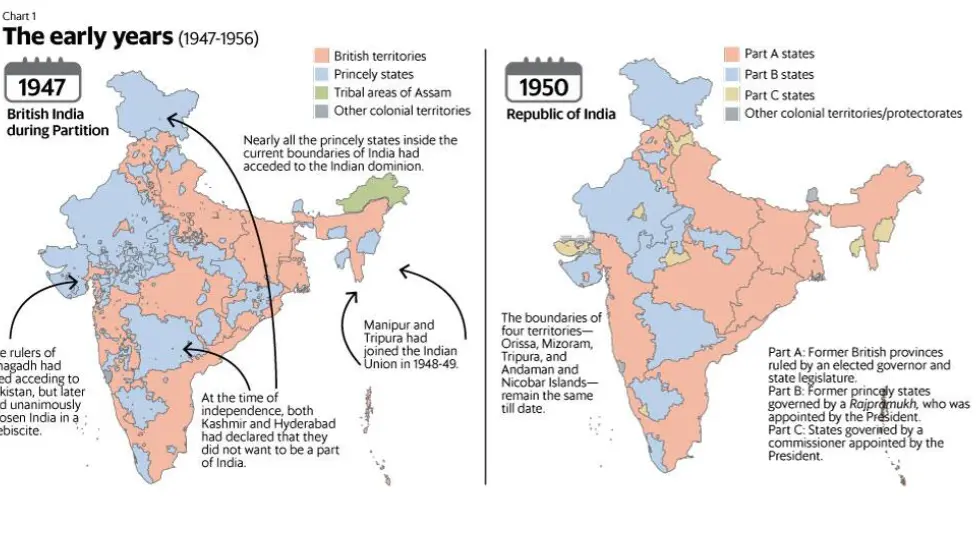State Reorganization Act of 1956 – Evolution, Linguistic & Cultural Transformations, Progress, Unity |
India’s Post-Independence State Reorganization Journey with a Focus on the State Reorganization Act
The British colonial administration had organized the Indian subcontinent into provinces and princely states without necessarily considering linguistic or cultural affinities, which led to administrative difficulties and tensions in post independence. After India gained independence from British colonial rule in 1947, the issue of Reorganisation of states based on linguistic and cultural diversity became a significant concern.
Transforming India: Evolution of Linguistic States and the Impact of the State Reorganization Act of 1956
- Demand In the Constituent Assembly: In the Constituent Assembly demands for linguistic Reorganization of states were raised.
- Leaders thought that immediately after partition, creation of linguistic states might create further tension and postponed the decision.
- However, Parliament was given the power to create new states or merge old states or parts of such states or alter boundaries in future.
- Appointment of Commissions: At the time of independence, British India consisted of 17 provinces and more than 550 princely states.
- To address this issue, the Indian government initiated a process of state Reorganization and appointed Commissions to look into the feasibility of Reorganisation.
- Birth of the First Linguistic State: In 1953, the first linguistic state of Andhra for Telugu-speaking people was born.
- Consequently, there were similar demands for creation of states on linguistic basis from other parts of the country.
- The State Reorganization Act of 1956: Above circumstances led to passing of the State Reorganization Act of 1956. This act recognizes the importance of language as a significant marker of identity and culture in a diverse nation like India.
| Also Read: REORGANISATION OF STATES: FORMATION, LINGUISTICS CHALLENGES AND BEYOND |
Evolution of States and Union Territory in India’s Constitutional Landscape (1950-1956)
- In 1950, The Constitution of India, divided the states of the Indian Union into four categories or parts (Total 29 states or provinces)
- Part A: 9 former governor’s provinces
- Part B: 9 former princely states
- Part C: former princely states + chief commissioners provinces
- Part D: Andaman and Nicobar
| In this classifications, Part A states had a Governor, Part B states had a Rajpramukh and Part C states had a commissioner |
State Reorganization Act: A Critical Assessment of Linguistic Considerations by Dhar Commission and JVP Committee (1948)
- Ad-Hoc Integration of Princely States: The integration of princely states with the rest of India has purely an ad-hoc arrangement.
- The S.K. Dhar Commission: Government of India appointed the Linguistic Provinces Commission under the chairmanship of S.K. Dhar in June 1948 to examine the feasibility and evolution of an objective criteria.
- Committee recommended the Reorganisation of states on the basis of administrative convenience rather than linguistic factors (Report in Dec 1948)
- The JVP Committee: Disappointment with the Dhar committee led to the appointment of another Linguistic Provinces Committee in December 1948 itself.
- It consisted of Jawaharlal Nehru, Vallabhai Patel and Pattabhi Sitaramayya, to examine the whole question afresh (Famously known as JVP Committee).
- The JVP committee formally rejected language as the basis for Reorganization of states but said that the issue could be looked at afresh in the light of public demand.
| Also Read: INDIAN CITIZENSHIP: CONSTITUTIONAL PROVISIONS, LEGAL FRAMEWORK, AND RIGHTS & DUTIES OF CITIZENS |
How did the States Reorganisation Commission of 1953 affect the Linguistic Basis and how did the State Reorganization Act affect India’s Diversity and Unity?
- Potti Sriramulu’s Sacrifice: A prolonged agitation and the death of Potti Sriramulu after a 56-day hunger strike, The government was forced to separate the Telugu speaking areas from the state of Madras which led to formation of Andhra Pradesh.
-
- Consequently, there were similar demands for creation of states on linguistic basis from other parts of the country.
- The States Reorganisation Commission: This forced the Government to appoint a three-member States Reorganisation Commission in 1953, to re-examine the whole question.
- Members: Fazl Ali (chairperson), K.M. Panikkar and H.N. Kunzru.
- Committee broadly accepted language as the basis of Reorganization of states.
- At the same time, it rejected the theory of “One Language-One State”.
- Its view was that the unity of India should be regarded as the primary consideration in any redrawing of the country’s political units.
- It identified four major factors that can be taken into account:
- Preservation and strengthening of the unity and security of the country.
- Linguistic and cultural homogeneity.
- Financial, economic and administrative considerations.
- Planning and promotion of the welfare of the people in each state as well as of the nation as a whole.
- Fazl Ali Commission also suggested the abolition of the four-fold classification of states under the original Constitution and creation of 16 states and 3 centrally administered territories.
Shaping Modern India: Transformative Impact of the State Reorganization Act of 1956
The Government of India accepted the recommendation of Fazl ALi Commission with certain minor modifications. The States Reorganisation Act (1956) and the 7th Constitutional Amendment Act (1956) passed for Reorganization of the states and provinces.
- Objective: The primary aim of this act was to create states based on linguistic lines, recognizing the importance of language as a significant marker of identity and culture in a diverse nation like India.
- Abolishment of Part-A and Part-B States: The act did away with the distinction between Part-A and Part-B states and Part-C states were abolished.
- Some of them were merged with adjacent states and some others were designated as union territories.
- Ongoing Reorganizations: The process continued over the years, leading to further Reorganisations and the formation of new states to accommodate these considerations.
| Also Read: UNDERSTANDING THE PREAMBLE OF INDIAN CONSTITUTION: SIGNIFICANCE, EVOLUTION, AND CONTEMPORARY DEBATES |
Legacy and Key Features of the State Reorganization Act of 1956
- Formation New States: The act led to the creation of new states and the Reorganisation of existing ones based on the predominant language spoken by the population.
- It created 14 states and 6 union territories on November 1, 1956, replacing the previous classification of states (Part A, B, C, and D) with the 7th Constitutional Amendment Act of 1956.
- The former Part B State of Hyderabad was merged with Andhra State to create the larger Andhra Pradesh State.
- The former Part B State of Mysore was transformed into the significant state of Karnataka with additional territories transferred from the States of Madras (Tamil Nadu) and Bombay.
- Further, it merged the Madya Bharat state, Vindya Pradesh state and Bhopal state into the Madhya Pradesh state.
- Preservation of Existing States: States that had a common linguistic identity were often retained, but they were sometimes adjusted in terms of boundaries to align with linguistic considerations.
- Example: The State of Kerala was carved out of the former Part B State of Travancore-Cochin with new territories acquired from the State of Madras
- Bilingual States: In some cases, states were declared as bilingual, recognizing that multiple languages might be spoken in a region.
- Example: It merged the Saurashtra state and Kutch state (Gujrathi speaking) into that of Bombay (Marathi speaking) and created a bilingual state of Bombay.
- Promoted the Linguistic and Cultural Identity: This Reorganization was a significant step in India’s post-independence history, as it recognized the importance of linguistic and cultural identity in governance and administration.
- Example: It created the new union territory of Laccadive, Minicoy and Amindivi Islands from the territory detached from the Madras to preserve its cultural distinctiveness.
Article-350A
|
Post-1956 State Reorganization Act and the Evolution of India’s New States
- Birth of States in 1956: The new States formed as a result of the reorganization of States in 1956 are Andhra Pradesh, Bombay, Kerala, Madhya Pradesh, Madras, Mysore, Punjab and Rajasthan.
- Dynamic Evolution: The political map of India underwent continuous change due to the pressure of popular agitations and political conditions.
- The demand for the creation of more states on the basis of language or cultural homogeneity resulted in the bifurcation of existing states.
- Legislative Responses: Thereafter the Parliament had also enacted various Reorganisation Acts from time to time
- Example: The Bombay Reorganisation Act in 1960; The Punjab Reorganisation Act in 1966; the State of Himachal Pradesh Reorganisation Act in 1970 and North-Eastern States reorganization Act in 1971.
- Parliamentary Reshaping in 2000: The last major reorganization was the Reorganisation Acts of Uttar Pradesh, Madhya Pradesh and Bihar which were enacted by the Parliament in November, 2000.
- The Telangana Movement: The latest in this category was the Andhra Pradesh Reorganisation Act of 2014, that split the state of Andhra Pradesh into Telangana and the residuary Andhra Pradesh state, following the Telangana movement.
Andhra State Act, 1953 and the Genesis of Linguistic States in India
- Formed the first linguistic state, known as the State of Andhra, by taking out the Telugu speaking areas from the State of Madras. Kurnool was the capital of Andhra State and the state high court was established at Guntur.

| Serial Number | Name of New State | Description |
| 15th state | Gujrat, 1956 |
|
| 16th state | Nagaland |
|
| 17th State | Haryana, 1966 |
|
| 18th State | Himachal Pradesh |
|
| 19th, 20th and 21 First | Manipur, Tripura and Meghalaya Respectively, 1972 |
|
| 22 Second | Sikkim, 1975 |
|
| 23rd, 24th and 25th | Mizoram, Arunachal Pradesh and Goa Respectively ,1987 |
|
| 26th, 27th and 28th | Chhattisgarh, Uttarakhand and Jharkhand |
|
| 29th | Telangana, 2014 |
|
| Also Read: SCHEDULES OF INDIAN CONSTITUTION: 12 SCHEDULES NURTURING DEMOCRACY |































